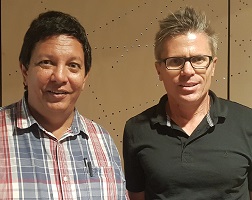Rural Round-up: the rise and rise of rural generalism
 Nick Schubert (right), is a PhD Candidate, at James Cook University (Australia)
and Tarun Sen Gupta (left), is professor, College of Medicine & Dentistry,
James Cook University (Australia). They write about rural generalism.
Nick Schubert (right), is a PhD Candidate, at James Cook University (Australia)
and Tarun Sen Gupta (left), is professor, College of Medicine & Dentistry,
James Cook University (Australia). They write about rural generalism.
Family doctors world-wide are familiar with workforce challenges and generalist practitioner shortages [1], which are most prevalent in rural communities and areas of socio-economic disadvantage [2-5]. Rural workforce shortages have been identified by the World Health Organization as a significant barrier to universal, equitable health coverage [6]. Common drivers for these shortages include: the increasing trend toward metropolitan based medical specialization [7]; feminisation and ageing of the medical workforce; changing work priorities of younger doctors; changing attitudes toward owning a general practice; and, negative perceptions of both rural and general practice [8, 9].
Rural Generalist Medicine (RGM) has been a feature of medicine in countries with large rural and/or remote areas for some time [10, 11], despite variations in rural generalist titles, nature of training programs and models of care. A renewed commitment to coordinated RGM training now offers a way forward for all jurisdictions and is attracting considerable international attention, including a summit at the 2017 WONCA rural conference in Cairns.
The Cairns Consensus Statement (2014), describes Rural Generalist Medicine as ‘the provision of a broad scope of medical care by a doctor in the rural context that encompasses the following:
• Comprehensive primary care for individuals, families and communities;
• Hospital in-patient and/or related secondary medical care in the institutional, home or ambulatory setting;
• Emergency care;
• Extended and evolving service in one or more areas of focused cognitive and/or procedural practice as required to sustain needed health services locally among a network of colleagues;
• A population health approach that is relevant to the community;
• Working as part of a multi-professional and multi-disciplinary team of colleagues, both local and distant, to provide services within a ‘system of care’ that is aligned and responsive to community needs’ [12].
A recent scoping review addressed the broad question ‘What is documented on rural generalist medicine?’ identifying 102 relevant articles [13]. Themes explored in the review included contextual differences and similarities in: the definition of RGM; the training pathways and programs; the scopes of practice and service models; the enablers and barriers to recruitment; and, retention and recommendations for reform.
Whilst most literature originates from the relatively mature RGM models in Australia, Canada and the USA, there is also more recent literature emerging from countries such as Japan, Kenya, Uganda, Rwanda, Ethiopia and India. Efforts to coordinate and strengthen RGM pathways and models of care as a response to the issues faced globally by the health sector in rural and remote areas are also now being shared through forums such as the World Summits on RGM. Ongoing research and publication of evidence related to RGM training and health outcomes is now required to support best practice outcomes as this momentum continues to build.
The
WONCA Working Party on Rural Practice has been instrumental in leading international discussion and collaboration as the field of rural generalist medicine evolves and will have a focus on this topic at the forthcoming conference in New Mexico. While many elements of rural generalist medicine will be familiar to family doctors everywhere, the Australian College of Rural & Remote Medicine has described rural and remote medicine as ‘the fullest expression of the specialty of general practice [14].’
We are optimistic that RGM will bring great benefits for our patients and our communities, and help us realise the working party’s vision of health for all rural people around the world.
References
1. Ono T, Schoenstein M, Buchan J: Geographic Imbalances in Doctor Supply and Policy Responses. (OECD Health Working Papers DfE, Labour and Social Affairs, Health Committee ed.: OECD Publishing; 2014.
2. Philpott J, Cornelson B, Derbew M, Haq C, Kvach E, Mekasha A, Rouleau K, Tefera G, Wondimagegn D, Wilson L, Yigeremu M: The dawn of family medicine in Ethiopia. Fam Med 2014, 46:685-690.
3. Monjok E, Essien EJ, Smesny A, Okpokam SN: A training need for rural primary care in Nigeria. Journal of Obstetrics and Gynaecology 2010, 30:833-835.
4. Holst J: Rethinking Medical Training in Germany Towards Rural Health Care. Primary Health Care: Open Access 2015, 5:1-6.
5. Hussain R, Maple M, Hunter SV, Mapedzahama V, Reddy P: The Fly-in Fly-out and Drive-in and Drive-out model of health care service provision for rural and remote Australia: benefits and disadvantages. Rural and Remote Health 2015, 15:1-7.
6. World Health Organization: Global strategy on human resources for health: Workforce 2030. 2016.
7. Hart G: Health care workforce supply in underserved rural areas of the United States. In 5th International Medical Workforce Conference. Sydney: National Rural Health Association, Washington DC; 2000.
8. de Klerk B: President's message. Generalism is dead: Long live generalism! Can J Rural Med 2013, 18:121.
9. Battye K, White C, Cronin S, Bond N, Mitchell C: Solutions to the provision of primary care to rural and remote communities in Queensland. Health Workforce Queensland; 2005.
10. NOVA Public Policy P/L: Review of the Queensland Health Rural Generalist Pathway (RGP) model to examine whether there is the potential to expand the model nationally.; 2010.
11. Duns G: Challenges and rewards--a career as a generalist. Australian Family Physician 2013, 42:439-439.
12. Australian College of Rural and Remote Medicine: Cairns Consensus Statement on Rural Generalist Medicine: Improved health for rural communities through accessible, high quality healthcare.: Australian College of Rural and Remote Medicine; 2014. http://www.acrrm.org.au/docs/default-source/documents/about-the-college/cairns-consensus-statement-final-3-nov-2014.pdf
13. Schubert N, Evans R, Battye K, Sen Gupta T, Larkins S, McIver L: International approaches to rural generalist medicine: a scoping review. Human Resources for Health 2018, 16:62.
14. Australian College of Rural and Remote Medicine. Position Statement- Defining the Specialty of General Practice